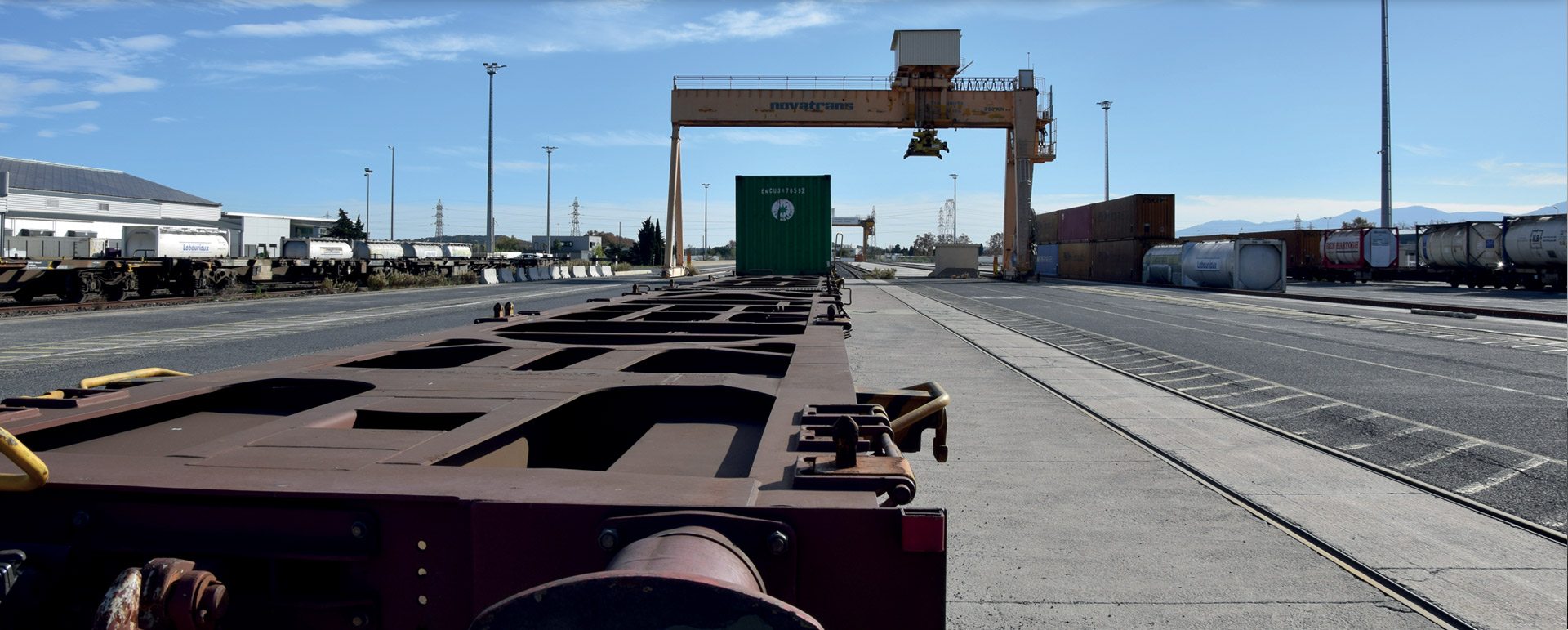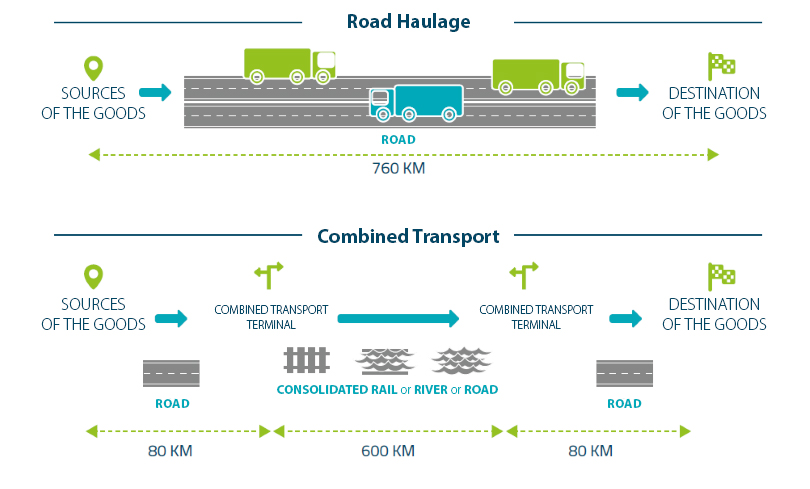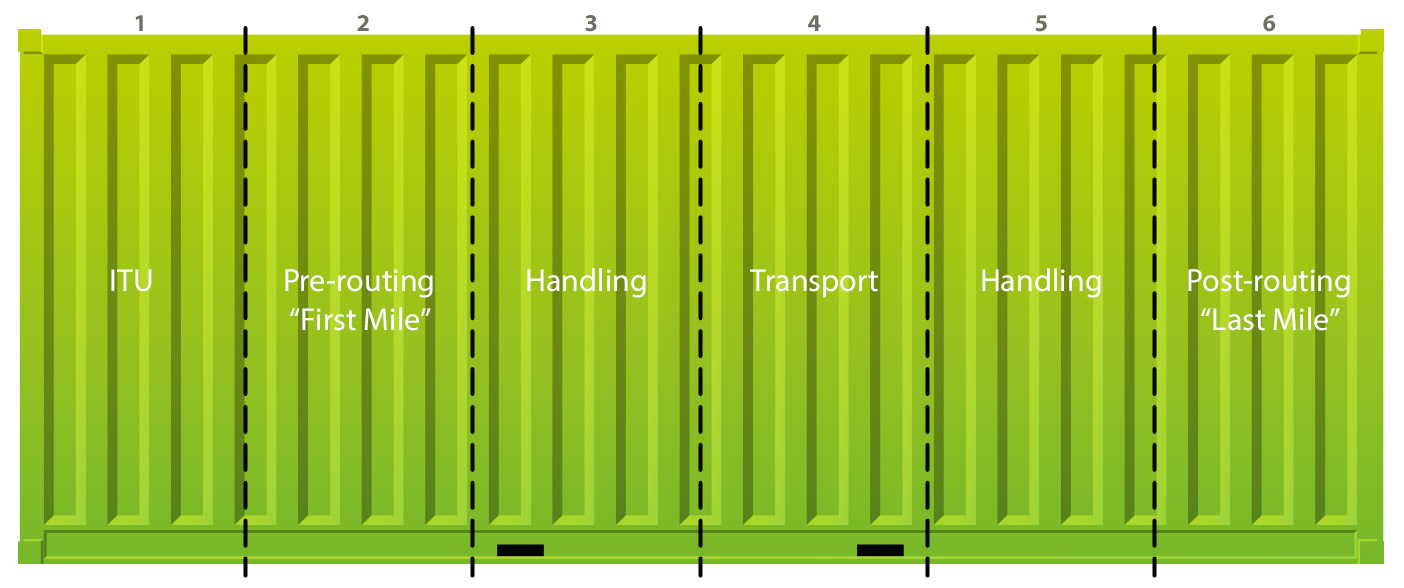
FAQ
The responses below to these Frequently Asked Questions (FAQ) endeavour to respond to all the questions you may have about combined transport.

Combined transport brings together at least two modes of transport for the shipment of goods in intermodal transport units (ITUs) in the transport chain. The ITU (container, swap body, tanker, etc.) is transshipped from one mode of transport to another: e.g. from rail to road or from barge to road, using lifting gear, at dedicated maritime, river and rail terminals.
Combined transport currently represents 21% of rail transport and 10% of river transport (Source: GNTC 2017) and has been steadily developing for 10 years under the threefold effect of road congestion, the CSR policies of the commissioning parties and COP21.
Combined transport offers a number of advantages. It helps to improve quality of life and proposes a reliable transport solution in order to enhance productivity along the entire logistics chain. The main advantages of combined transport can be summed up as follows:
- It is good for the environment: on those routes on which volumes can be grouped together and where the distance is appropriate, combined transport results in substantial energy savings and reduces CO2 emissions.
- It is good for society: it means fewer accidents and traffic jams and reduces our dependence on fossil fuels (1).
- It results in a more efficient use of the capacity available on the rail and river networks.
- It combines the flexibility of road transport with the savings of rail transport over long distances for large volumes.
- It is well integrated into the logistics chain.
- It is safe and secure: it lessens the risk of theft of or damage to goods during shipping.
(1) We can provide customised energy savings certificates for your internal and external needs.
The Intermodal Transport Unit (ITU): containers, swap bodies and semi-trailers suitable for intermodal transport. The swap body is a simple type of container intended exclusively for combined rail/road transport. The container is a metal box that comes in standard dimensions used for storage and handling at ports or multimodal combined transport hubs.

* externals dimensions
The cost of a combined transport shipment comprises several elements which cover each stage in the logistics chain:

1. ITU
A combined door-to-door goods transport service uses an ITU (intermodal transport unit) provided by the road haulier, the transit agent or the maritime shipping company.
2. Pre-routing “First Mile”
The unit travels a short distance by road from the place at which it is loaded (factory, warehouse, etc.) to a combined transport terminal or a maritime terminal.
3. Handling
The unit is unloaded from the lorry to be loaded on to the consolidated means of transport (train or barge).
4. Transport
After handling, the goods are routed by rail or river for the larger part of their journey to a second combined transport terminal or a maritime terminal.
5. Handling
The unit is unloaded from the train or barge to be loaded on to the lorry.
6. Post-routing “Last Mile”
After handling, the goods resume their journey for a short distance by road to be delivered to their final destination.
Novatrans and Greenmodal Transport can handle all types of registered intermodal transport units:

* external dimensions
With the help of EDI, we incorporate our customers’ orders in our transport tools.
Manual input and processing are replaced by reliability and rapidity.
EDI is also involved in the provision of customer information on the CESAR exchange platform.
Over and above exchanges with our customers, EDI flows are in place with our many business partners, whether railway or terminal operators.
Did you know that CESAR celebrated its 15th birthday in 2019? CESAR is the common European platform for exchanging information on shipments between combined transport operators and their customers (www.cesar-online.com). When you log on you can track the routing of your units. Your data are attached to the operator used and therefore remain confidential.
Each year, CESAR processes data on 2.3 million loading units, i.e. two-thirds of the total volume of UIRR companies. At the present time more than 400 customers use this system. CESAR operates in four languages and can be accessed 24/7.- We track the punctuality and regularity of our services and we regularly publish the KPIs.
- We manage the Quality Agreements with the national rail network.
- We control our trainpaths on the French network which give us control over the transport schedule.
- We provide a daily overnight service that allows short A-to-B transit times, which are very competitive compared with all-road routing in France and the rest of Europe.
First of all, you save on the storage cost of your goods in containers at our inland terminals which are very much lower than the costs of the terminals at maritime ports.
You also save on the total storage time of your goods on land as during the period in which your goods are travelling on our barges and trains is free of storage charges!
Lastly, you save on the cost of moving empty containers which we manage as closely as possible to your future needs. Indeed, we serve the empties depots for maritime shipping at the main inland depots (Dourges, Lyons, Paris, Ludwigshafen, etc.) and ports (Le Havre, Dunkirk, Marseilles, Rotterdam, Antwerp, Zeebrugge, Hamburg, etc.).You save on the total storage time of your goods on land, since the period in which your goods are travelling on our barges and trains is free of storage charges.
You also save thanks to the AtoB transit time in our transport schedule, which helps to limit the number of ITUs used.